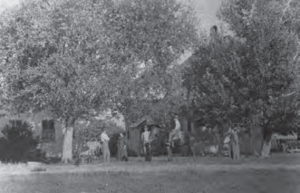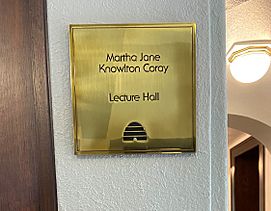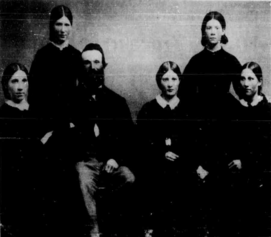Martha Jane Knowlton Coray facts for kids
Quick facts for kids Martha Jane Knowlton Coray |
|
|---|---|
 |
|
| Board of Trustees, Brigham Young Academy | |
| October 1875 – December 14, 1881 | |
| Called by | Brigham Young |
| Personal details | |
| Born | Marth Jane Knowlton June 3, 1821 Covington, Kentucky |
| Died | December 14, 1881 (aged 60) Provo, Utah |
| Notable works | History of Joseph Smith by His Mother |
| Spouse(s) | Howard Coray |
| Children | Howard Knowlton Coray (b. 1842) Martha J. Knowlton Coray (b. 1844) Harriet Virginia Knowlton Coray (b. 1846) Mary Knowlton Coray (b. 1848) Euphrenia Serephia Coray (b. 1850) Helena Knowlton Coray (b. 1852) William Henry Coray (b. 1853) Sidney Algernon Coray (b. 1855) Wilford Coray (b. 1856) George Quincy Coray (b. 1857) Frances DeLaVan Coray (b. 1860) Louis Laville Coray (b. 1862) Don Silas Rathbone Coray (b. 1864) |
| Parents | Sidney Algernon Knowlton Harriet Burnham Knowlton |
Martha Jane Knowlton Coray (June 3, 1821 – December 14, 1881) was an important Mormon pioneer, a skilled record keeper, and a dedicated educator. She made history as the only female member of the first board of trustees for Brigham Young Academy.
Born in Kentucky, Martha grew up in Ohio and Illinois. She joined the Church of Jesus Christ of Latter-day Saints when she was young. Later, she moved to the Mormon settlement of Nauvoo. There, she helped Lucy Mack Smith, the mother of Joseph Smith (who founded the Latter Day Saint movement), write a book about Joseph's life. This book was later published as History of Joseph Smith by His Mother.
After traveling across the Great Plains with other Mormon pioneers, Martha settled in Utah Territory. She lived in towns like Tooele and Mona. She helped her family earn money by making dairy products, creating home remedies, and doing other crafts. Even though she never went to a formal school, Martha studied many subjects on her own. She also taught her children everything she knew. She was very interested in law and often got involved in local court cases and political talks.
In 1875, Martha Coray was chosen to be on the first Brigham Young Academy Board of Trustees. She was the only woman on the board at that time. While serving, she worked hard to encourage young women to get an education. She also helped create a plan for religious education at the Academy. Today, a lecture hall at Brigham Young University is named after her. In 1997, the university honored her achievements during its homecoming celebrations.
Contents
Early Life and Faith
Martha Jane Knowlton Coray was born on June 3, 1821, in Covington, Kentucky. She was the third of ten children. Her parents, Sidney Algernon Knowlton and Harriett Burnham, came from New England. Her family moved often across the Midwestern United States during her childhood. They lived in places like Cumminsville, Ohio and Bear Creek, Illinois.
As a child, Martha attended a Campbellite church. When she was just ten years old, she taught a Sunday School class to students older than herself. In 1838, while living in Hancock County, Illinois, she first learned about Mormonism. Her father offered work and a place to stay for some Latter Day Saint refugees. Martha started going to their religious meetings. She listened to many speakers, including George A. Smith. His talks convinced her to join the Church of Jesus Christ of Latter-day Saints.
In January 1840, she was baptized by John E. Page in the very cold Mississippi River. They had to cut a hole in the ice for the baptism. A few weeks later, on January 21, 1840, Joseph Smith Sr. gave Martha a special blessing. He said she would have the gift of tongues and the gift of prophecy. Martha was the first person in her family to join the LDS faith.
Life in Nauvoo

On February 6, 1841, Martha married Howard Coray in her father's house in Nauvoo, Illinois. She was nineteen, and Howard was twenty-four. They had met at a church meeting and wrote letters to each other for a few months before their wedding. Howard wrote in his journal that he quickly saw Martha was "ready, off hand, and inclined to be witty." Joseph Smith, the founder of the Latter Day Saint movement, approved of their marriage. Martha got to know Joseph Smith through her husband, who worked as Smith's clerk. Howard said that Martha "valued her acquaintance with him above everything else."
After her baptism and before her marriage, Martha started writing down Joseph Smith's speeches in a small notebook. At that time, there was no official way to keep records in the LDS Church. Martha had been writing down what she saw since she was thirteen. She kept detailed notes of her daily life. Her daughter, Martha Coray Lewis, said that her mother "preserved notes of sermons that would otherwise have been lost to the Church." In Nauvoo, she recorded talks by George A. Smith, Brigham Young, John Taylor, and Joseph Smith. Years later, Wilford Woodruff, who became the church historian, asked for Martha's notes from this time. Often, her husband would help her write down Smith's speeches. They were known as "a team committed to meticulous documentation."
Martha and Howard Coray went to the Nauvoo Temple in January 1846 for a special ceremony called the endowment. The Corays were later sealed together in January 1846 by Brigham Young. While living in Nauvoo, Martha Coray served as the secretary of the Relief Society, the women's organization of the LDS Church. She also gave birth to her first child, Howard Knowlton Coray, on April 10, 1842.
In the early years of their marriage, the Corays stayed in Nauvoo and taught school together. They rented a room from Robert B. Thompson for their school. They taught as many as 150 students at a time. As a teacher, Martha enjoyed teaching subjects like "law, philosophy, history, poetry, chemistry, and geology." She taught until 1844, when Lucy Mack Smith hired her to write a book about her son, Joseph Smith.
Writing Joseph Smith's History
Martha Coray played a key role in preserving the history of the LDS Church. She wrote the history of Joseph Smith as told by his mother, Lucy Mack Smith. Martha's work involved writing down Lucy Mack Smith's stories about her son's life. She listened and recorded the stories regularly. At the end of each day, she would edit what she had written. Martha found some information in letters and documents, but most of the book came from Lucy Mack Smith's spoken words. This project often required daily effort.
Researcher Elizabeth Anderson said Martha's work on the book came from her "deep admiration and love for the Prophet Joseph Smith." She wanted to save Smith's history so her children could read it in the future. Martha felt that her earlier experience writing down Smith's speeches had prepared her for this important work. Howard Coray later joined his wife in this effort. The final book was finished in 1845, after about a year of work. The Corays had two copies printed: one for Lucy Mack Smith and one for the church's records.
There is some discussion about who wrote most of the book. Years later, Brigham Young said Martha Coray led the project. However, Howard Coray's sister said her brother was the main author. The original manuscript has handwriting from both Howard and Martha. But the writing style often sounds like Lucy Mack Smith herself. It is also not clear if the idea to write the history came from Martha or Lucy Mack Smith. We do know that Martha wanted to create a book of short stories from Smith's life to help teach children about him.
In 1853, Orson Pratt published copies of the book in England. It was called "Biographical Sketches of Joseph Smith the Prophet, and His Progenitors for Many Generations." In Utah, the book was later taken back. Brigham Young and some LDS historians said it contained mistakes. Young, who was the church president, was also upset that the book was published without his permission. He publicly criticized Martha's writing. While she was alive, Martha never gave permission for the book to be printed again. But the book was later published in the Improvement Era in 1903 and again in 1945. It was then called "History of the Prophet Joseph, by His Mother."
Moving West
In the spring of 1846, Martha Coray left Nauvoo. Like most Latter-day Saints, she traveled west. To earn money for the journey, the Coray family worked as government farmers and ferry boat operators. They worked in places like Kanesville, Iowa, Fort Kearny, and along the Missouri and Nishnabotna Rivers. While living in these areas, they often helped Mormons who had been forced to leave Missouri. The Corays reportedly sold the windows and doors of their Nauvoo home for $10 before they left.
They traveled west to Utah Territory with the John Sharp company. Martha was twenty-seven years old. She had five children under the age of eight to care for during the journey. Her children were Howard, Martha, Harriet, Mary, and Euphrina. She gave birth to three more children along the way. By the time the family arrived in the Salt Lake Valley in 1850, they had six children.

Frontier Life
The Corays' first home in Utah was a house next to the Salt Lake Theatre. Martha was a member of the Thirteenth Ward Relief Society in Salt Lake City. She served as the organization's first secretary. In 1855, the family moved to Tooele, Utah. There, Martha managed dairy production on their farm.
Not happy with life in Tooele, the Corays moved again. They divided their time between a house in Provo and a farm in Mona. With this move, Martha changed her home business. Instead of making cheese, she started making soap and distilling ointments. Her soap production was the family's way of helping the United Order. This was a plan to help Latter-day Saints become self-sufficient.
The Coray family often faced money problems. During times of hunger, Martha would feed her children watercress, lilies, rabbit meat, and wild onions. She also made candles from tallow. The children would then sell these candles to the community. Over the years, Martha's role changed between being a frontierswoman and a middle-class wife. This depended on the family's money situation. Martha always stepped in to help Howard financially when needed. However, throughout her adult life, she had health problems, mainly a "persistent cough."
Home Chemistry
When Brigham Young started suggesting that women work outside the home, Martha joined other women in looking for new jobs. She was interested in chemistry. She spent time creating her own oils, shampoos, and other products. One product was her "Lightening Cage Oil." She claimed it "would render [an assailant] helpless" if applied. In contrast, the sage oil she made was used for medicine. Church leaders at the time encouraged the use of herbal medicine, like the kind Martha made. So, it was popular in her community. She started a small business selling these homemade ointments and medicines along the Wasatch Front. Martha's home chemistry was "more than a hobby; she ... produced and marketed a viable medical product." She also became interested in obstetrics after one of her daughters died during childbirth. She was also good at assaying minerals. Another of her daughters later said that chemistry and geology were Martha's favorite subjects to study.
Education
Martha Coray believed education was very important in her home. She led the teaching of her children. In her journal, she wrote about teaching them reading, writing, grammar, and arithmetic regularly. Even though chores to support the family always came first, Martha had an "unusual dedication to education." She tried to balance her duties as a wife and mother with her own learning. She borrowed books from friends and took classes in music and religion. She was very interested in studying the Bible.
Even though she never went to a formal school herself, she taught school many times throughout her life. While her husband, Howard, was serving as a Latter-day Saint missionary, Martha took his place teaching at the University of Deseret (now the University of Utah). She also taught Sunday School and served on the local LDS Sunday School Board. Her son George later went to Cornell University and became a professor at the University of Utah. Her daughter Martha Jane Coray Lewis became a writer. Towards the end of her life, her grown children moved to Mona. They built homes for their own families on the Coray property and lived there.
Law and Community Involvement
Once her children were grown and she had more free time, Martha Coray became involved in Utah politics. Her main goal was to help the Latter-day Saints keep their independence in Utah Territory. She helped by making homemade medicines and health products. She also helped start a Latter-day Saint-run school. At that time, schools in Utah Territory did not have stable financial support.
Martha had her own income, voted in local elections, and owned land. The Salt Lake City Land Office required landowners to live on their property. So, the Corays put their Provo home in Martha's name. This allowed them to keep both that property and their farm in Mona. Martha also worked as a representative for the Woman's Exponent, a publication for LDS women, in Nephi and Mona. She sold subscriptions and subscribed herself. Besides the histories she recorded, Martha wrote articles about women's rights. Some of her writing was published in the Exponent.
Martha also had an interest in law. Several times, she asked about getting patents for some of her homemade products and how she made them. She also gave advice to friends and neighbors on legal matters. She often had power of attorney for them and appeared in court. She took charge of legal matters for irrigation projects in Juab County, Utah. These projects later became the Mona Irrigation District. Martha never went to law school or had formal legal training. But her involvement in legal matters was common in Utah at that time. Her legal knowledge was very helpful when family members wanted to start businesses or buy land. Her daughter Martha described her as "a rapid and lucid writer, a brilliant conversationalist, and a fine speaker on a wide range of subjects," including history, philosophy, poetry, and law.
Brigham Young Academy
When the LDS Church's education system was being created, Brigham Young made a rule. He said that each academy board must include at least one woman. Martha Coray was chosen by Young in October 1875 to be the first woman on the board of trustees for Brigham Young Academy (BYA). She served on the board until she passed away in 1881. She was also named the first Dean of Women at Brigham Young Academy.
Even before her appointment, Martha made sure to keep Young (who was the president of the LDS Church and governor of Utah Territory) informed about issues concerning education for women in Utah. As a board member, Young asked Martha to focus on making sure young women attended the Academy. Her goal was "to act as a mouthpiece for their interests."
The first board of trustees of BYA worked on creating the school's curriculum. Martha worked with her colleagues to balance regular subjects with religious teachings. Her belief was that combining religious and secular learning would lead to the best education possible. In a letter to Brigham Young, she stated: "My principle of education has been God's laws of religion first, Man's laws of honor and morality second, [and] Science of every attainable kind [third]". While at BYA, she also helped hire Warren Newton Dusenberry and Karl G. Maeser. She was on the executive committee, the committee for rules and by-laws, and the auditing committee at BYA. Throughout her time at the Academy, Martha wrote many letters to Brigham Young. She kept him updated on things like student enrollment and the curriculum.

While serving as a trustee, she wrote: "I am a little disappointed at the want of general interest shown in the B. Y. Academy at Provo. I am now so situated that I can give considerable attention to its workings and its struggling also to accomplish the greatest good, with the smallest amount of means". Many BYA students attended her funeral when she passed away.
Legacy
Martha Jane Knowlton Coray died on December 14, 1881, in Provo, Utah. She was 59 years old. She is buried in the Provo City Cemetery. Her funeral was held in the Provo Tabernacle on December 25, 1881. Speakers included Joseph F. Smith, Abraham O. Smoot, and Wilford Woodruff, who was then the president of the LDS Church. Hundreds of people gathered at her funeral service. Her husband, Howard, and eleven of her children survived her. By 1908, she had 50 grandchildren and 45 great-grandchildren.
Through her work as a trustee at Brigham Young Academy, she helped shape LDS religious education. This type of education is still important today through the Church Educational System. Martha also helped promote education for women in Utah. The lecture hall in the Karl G. Maeser Building on Brigham Young University (BYU) campus is named after Coray. Also, BYU's homecoming in 1997 celebrated Coray for her dedication to education. She was also very devoted to her faith. It influenced almost every part of her life. She was described as "a devout member of the Church and a competent writer," and also as "a woman of native brilliance and intense dedication."


